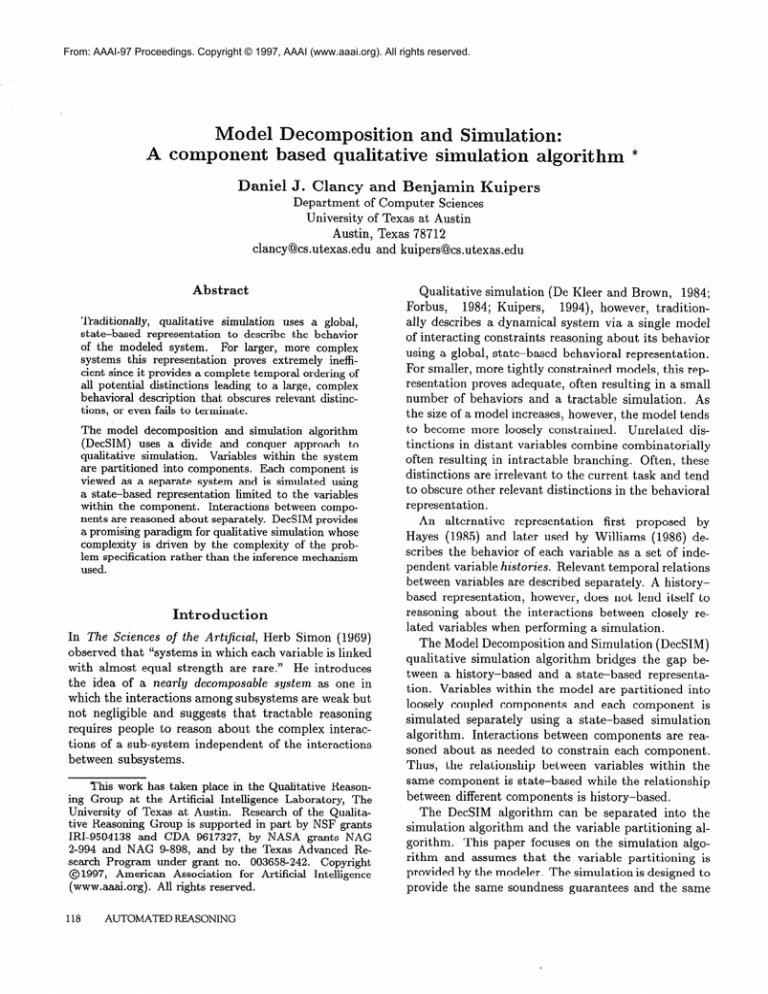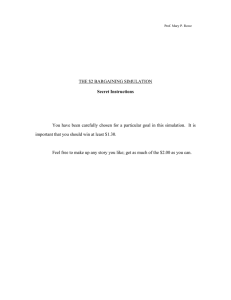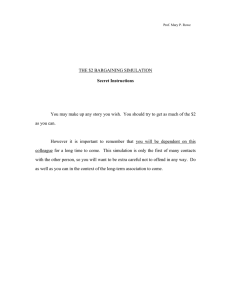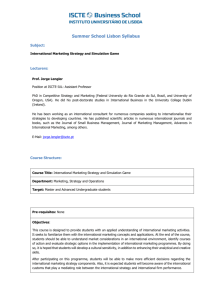
From: AAAI-97 Proceedings. Copyright © 1997, AAAI (www.aaai.org). All rights reserved.
Model
A component
Daniel
Decomposition
and Simulation:
based qualitative
simulation
algorithm
J. Clancy
and
Benjamin
*
Kuipers
Department
of Computer
Sciences
University
of Texas at Austin
Austin, Texas 78712
clancy@cs.utexas.edu
and kuipers@cs.utexas.edu
Abstract
Traditionally,
qualitative
simulation
uses a global,
state-based
representation
to describe the behavior
of the modeled system.
For larger, more complex
systems this representation
proves extremely
inefficient since it provides a complete temporal ordering of
all potential
distinctions
leading to a large, complex
behavioral
description
that obscures relevant distinctions, or even fails to terminate.
The model decomposition
and simulation
algorithm
(DecSIM)
uses a divide and conquer approach
to
qualitative
simulation.
Variables within the system
are partitioned
into components.
Each component is
viewed as a separate system and is simulated using
a state-based
representation
limited to the variables
within the component.
Interactions
between components are reasoned about separately. DecSIM provides
a promising paradigm for qualitative
simulation whose
complexity
is driven by the complexity
of the problem specification
rather than the inference mechanism
used.
Introduction
In The Sciences of the Artificial,
Herb Simon (1969)
observed that “systems in which each variable is linked
with almost equal strength
are rare.”
He introduces
the idea of a nearly
decomposable
system as one in
which the interactions
among subsystems are weak but
not negligible
and suggests that tractable
reasoning
requires
people to reason about the complex
interactions of a sub-system
independent
of the interactions
between subsystems.
This work has taken place in the Qualitative
Reasoning Group at the Artificial
Intelligence
Laboratory,
The
University
of Texas at Austin.
Research of the Qualitative Reasoning Group is supported
in part by NSF grants
IRI-9504138
and CDA 9617327,
by NASA grants NAG
2-994
and NAG 9-898,
and by the Texas Advanced
Research Program under grant no. 003658-242.
Copyright
Q 1997,
American
Association
for Artificial
Intelligence
(www.aaai.org).
All rights reserved.
118
AUTOMATED
REASONING
Qualitative
simulation
(De Kleer and Brown,
1984;
Forbus,
1984; Kuipers,
1994)) however,
traditionally describes a dynamical
system via a single model
of interacting
constraints
reasoning
about its behavior
using a global, state-based
behavioral
representation.
For smaller, more tightly constrained
models, this representation
proves adequate,
often resulting
in a small
number
of behaviors
and a tractable
simulation.
As
the size of a model increases, however, the model tends
to become more loosely constrained.
Unrelated
distinctions
in distant variables
combine
combinatorially
often resulting
in intractable
branching.
Often, these
distinctions
are irrelevant
to the current task and tend
to obscure other relevant distinctions
in the behavioral
representation.
An alternative
representation
first proposed
by
(1986) deHayes (1985) and later used by Williams
scribes the behavior
of each variable
as a set of independent variable histories.
Relevant temporal
relations
between variables
are described
separately.
A historybased representation,
however,
does not lend itself to
reasoning
about
the interactions
between
closely related variables
when performing
a simulation.
The Model Decomposition
and Simulation
(DecSIM)
qualitative
simulation
algorithm
bridges
the gap between a history-based
and a state-based
representation. Variables
within
the model are partitioned
into
loosely coupled
components
and each component
is
simulated
separately
using a state-based
simulation
algorithm.
Interactions
between components
are reasoned about as needed to constrain
each component.
Thus, the relationship
between
variables
within
the
same component
is state-based
while the relationship
between different
components
is history-based.
The DecSIM
algorithm
can be separated
into the
simulation
algorithm
and the variable
partitioning
algorithm.
This paper focuses on the simulation
algorithm
and assumes that the variable
partitioning
is
provided
by the modeler.
The simulation
is designed to
provide
the same soundness
guarantees
and the same
degree of constraining
power as a standard
state-based
qualitative
simulation
for arbitrary
variable
partitionings.
By partitioning
the model into smaller chunks, DecSIM significantly
reduces the overall complexity
of the
simulation
by eliminating
the temporal
correlations
between variables
in different
components.
Given an appropriate
partitioning
of the variables,
the complexity
of the DecSIM
algorithm
becomes a function
of the
problem
specification
rather
than an artifact
of the
simulation
algorithm.
Qualitative
Simulation
and
IIPecSIM
DecSIM
uses the QSIM qualitative
simulation
algorithm (Kuipers,
1994) as its core inference mechanism
when simulating
an individual
component.
QSIM uses
a qualitative
differential
equation
(&DE)
to specify
constraints
modeling
the structural
relationships
between the variables
within
a dynamical
system.
The
behavior
of the system is described
using a tree of alternating time-point
and time-interval
states. Variables
are described
using a qualitative
magnitude
and a direction of change. The qualitative
magnitude
is defined
upon a quantity
space of totally
ordered
landmarks
identifying
the relevant
distinctions
for that variable.
An event occurs when a variable reaches a landmark
or
becomes steady. Branches
occur within
the behavioral
description
whenever
multiple
events can occur following a time-interval
state. This is referred
to as event
branching.
Event branching
is exponential
in the number of unrelated
events. As a model grows, the number
of loosely or unrelated
events tends to grow, thus resulting in an intractable
simulation.
Model decomposition
uses a divide and conquer approach to control the problem
of event branching.
The
variables
within
the model are partitioned
into components so that closely related variables
are contained
within the same partition.
A sub-model
is created for
each partition
describing
the relationships
between the
variables within the partition.
This sub-model,
or sub&DE, is used to simulate
the component.
Two types
of variables
are contained
within
each sub-&DE.
Within-partition
variables
are the variables
belonging to the partition.
These are the variables
of
interest for this sub-&DE.
Boundary
variables
are
non-partition
variables
whose behavior
affects the overall behavior of the component.
These are variables
that are
related to within-partition
variable
via a constraint
within
the original
&DE.
Components
containing
boundary
components.
a boundary
A sub-&DE
variable are called
is comprised
of the
G-In
(glucose
,’
~-0~
(glucose
prod)
elimination)
( a) glucose
componeq
1
,------------------_I
/
I
I-In
/ (insulin
prod)
i
b) lnsulln
------------
component
,l ,
The models of the human Glucose-Insulin
Regulatory
System (GIR) contain two connected feedback loons corresponding to the glucose (a) and insulin (b) regulatory
systerns.
8 The nodes in the graph are variables and the links are
constraints.
The arrows indicate the direction of causality derived via a causal analysis.
m Two versions are used within the discussion. In the simpler version, the constraint
b2tween G and I-In
represented by the bold, dotted line is omitted and I-In
is
assumed to be constant.
The model is partitioned
into two components.
The boxes
delineate the within-partition
variables for each component
.
o In the simpler
nent
is causally
version
upstream
of the model,
and
the insulin
is simulated
prior
compoto
and
independent
of the glucose component.
e In the more complex version, G is a boundary
variable
of the insulin component,
and the two components
are
simulated concurrently.
Figure 1: Two
tory System
Models
of the Glucose/Insulin
Regula-
constraints
within
the main &DE which contain only
within-partition
and boundary
variables.
Figure 1 describes the partitioning
of-variables
and creation
of
sub-&DES
for two different
versions of a model of the
human glucose-insulin
regulatory
(GIR) system developed by Ironi and Stefanelli
(1993).
A causal analysis
(Iwasaki,
1988; Nayak,
1992)
is used to identify
the relationships
between
components.
Causally
upstream
components
are simulated
prior to the simulation
of the downstream
components.
A variable is only considered
a boundary
variable
with
respect to a component
C, if it is causally upstream
or
acausally related to a variable within C. For the example in figure 1, I-G is a boundary
variable
with respect
to the glucose component,
but GXl and G-Out are not
boundary
variables in the insulin component
sub-&DE.
Boundary
variables
are treated as exogenous
variables
whose behavior
is determined
by the simulation
of the
boundary
component.
If a feedback loop exists between a set of components
(as in the more complex version of the GIR model) or
if two components
are acausally
related (i.e the causal
QUALITATIVE
REASONING
119
analysis is unable to identify
an ordering),
then a concurrent
simulation
is used to derive the behavior
of
these components.
When performing
a concurrent
simulation,
the algorithm
iterates over the components
extending each component
a single time-step.
When reasoning about the behavior
of a boundary
variable,
the
simulation
assumes that the behavioral
description
of
the upstream
component
is complete
even though
it
is still being derived.
When a state is marked inconsistent due to a boundary
variable
(i.e. the value of
the boundary
variable
does not correspond
to a state
in the component
containing
the variable),
a dependency link is recorded.
If the simulation
of the boundary component
is extended
in a manner
that satisfies
the dependency,
the state that was previously
marked
inconsistent
is reinserted
into the behavior
tree and
successors of the state are computed.
A Model
of the
Regulatory
Glucose
System
AUTOMATED
REASONING
Component
Behavior
Tree
1
2
3
4
10
(4
(c)
Original
A standard
haviors
(a)
Behavior
Figure
Tree
QSIM
simulation
and 26 states.
A DecSIM
simulation
insulin
component
ior of the intermediate
glucose
component.
nent results
in four
Insulin
The GIR model contains two separate feedback loops.
One controls
the amount
of glucose (G) within
the
body and the other controls the amount of insulin
(I).
Two versions of the model are discussed.
In the more
complex version, the amount of glucose (G) controls the
rate of insulin production
(I-In)
while the amount of
insulin
(I)
affects the elimination
of glucose (G-Out)
via an intermediate
variable
(I-G).
Thus, a negative
feedback
loop exists between
these two components.
The simpler
version
models a pathological
condition
called glicemia
where the rate of insulin production
is
independent
of the amount of glucose within the body.
For the simpler version of the model, a causal ordering exists between the two components.
Thus, the insulin component
can be simulated
to completion
prior
to beginning
the simulation
of the glucose component.
Figure 2 describes the results from this simulation.
The more complex version of the model results in an
infinite
behavioral
description
due to the oscillatory
nature of the feedback
controlled
system. Intractable
branching
makes it difficult
to extend the simulation
sufficiently
to identify
the asymptotic
behavior
of the
system and evaluate
the results via a standard
QSIM
simulation.
With a state-limit
of 10,000, QSIM generates a total of 3340 behaviors,
none sufficiently
extended to identify
the asymptotic
behavior
of the system.
A DecSIM
simulation
with a component
state
limit of 300 generates
a behavior
tree with 74 behaviors for the insulin
component
and 84 behaviors
for
the glucose component
describing
a broader
range of
the state space. In the DecSIM simulation,
all of the
behaviors
are sufficiently
extended
to identify
the decreasing oscillatory
nature of the behavior.
The Dec120
12,3,A
(b) Insulin
2: Simpler
Component
Behavior
results
Tree
in a total
of 10 be-
generates
a single behavior
for the
that
is used to guide
the behavvariable
I-G when
simulating
the
Simulation
of the glucose
compobehaviors
(c).
(b)
Model
SIM simulation
also resulted
up in the simulation
time.
ecSHM
Glucose
Simulation
in a factor
Simulation
Results
of four
speed
Algorithm
The DecSIM simulation
algorithm
accepts a &DE and
a partitioning
of the variables within the &DE as input
and generates
a behavioral
description
for each partition.
The algorithm
can be divided
into two main
components:
decomposing
the model into sub-&DE’s,
and performing
the simulation.
Once a partitioning
is provided
by the modeler,
decomposing
the model involves creating
a sub-&DE
for each partition
and identifying
the within-partition
variables,
boundary
variables
and constraints
that belong within each sub-&DE
as described
previously.
A separate
QSIM simulation
is performed
for each
sub-model.
Three main extensions
are required to perform a component-based
simulation:
1) Boundary
variable
distinctions
must be eliminated
via abstraction
to
avoid
branches
within
a component
tree
due
to
non-component
variables;
2) the boundary
variable
behavior
guide
is used to restrict
the behavior
of
boundary
variables
when simulating
a boundary
component;
and 3) dependency
links must be maintained
and checked during a concurrent
simulation.
Eliminating
Boundary
Variable
Dist;inctions
A standard
QSIM simulation
provides a total ordering
of events for all variables
contained
within the model.
In a partitioned
simulation,
each sub-model
contains
both within-partition
and boundary
variables.
Since
each sub-model
is only required
to provide
a behav-
ioral description
for the within-partition
variables,
abstraction
is used to eliminate
branches caused by distinctions
in the values of the boundary
variables.
This
eliminates
the temporal
correlations
between withinpartition
variables
and boundary
variables
during the
simulation
of a sub-model.
The abstraction
process is performed
during the simulation
after the successors of a state are computed.
Equivalent
successor states with respect to the withinpartition
variables
are combined
to form a single abstract state. There are two main steps in the creation
and simulation
of abstract
sta,tes: 1) creating
an abstract state from a set of detailed
(i.e. non-abstracted)
successor states; and 2) computing
the successors of an
abstract
state.
Creating
an Abstract
State
An abstract
state
contains a unique value for each within-partition
variable. Qualitative
value information
for the boundary
variables is maintained
in the form of a disjunctive
list
of sub-states.
Each sub-state
contains
a complete
set
of values for the boundary
variables.
A sub-state
is
created for each detailed
state used to create an abstract state. The information
in the sub-states
is used
to ensure that no constraining
power is lost when the
successors of an abstract state are created.
Creating
Successors
of au Abstract
State
The
abstraction
process
eliminates
distinctions
in the
boundary
variables
which are normally
used by QSIM
when computing
a state’s successors.
The algorithm
used to create the successors of a state during a simulation
has been modified
to handle an abstract state.
These modifications
retain the QSIM soundness guarantee as well as the constraining
power of a standard
QSIM simulation.
The successors of an abstract state
are computed
as follows:
Step I:
QSIM
uses continuity
to determine
the
possible
successor values for each variable
within the model. For within-partition
variables, the unique qualitative
value provided
by the abstract state is used to compute the
set of valid successor values. For boundary
variables,
the union of the possible successor values for each distinct
boundary
variable value within
a sub-state
is used.
Step 2:
Use the standard
QSIM algorithm
to create and filter potential
successor states from
this set of possible values.
Step
3:
For each successor state, perform
a continuity test to ensure that the boundary
variable values can be reached from at least one
sub-state
maintained
by the abstract state.
original
states
S
I-,
map to
a single
abstract
state
- ‘\
,S
S 2 ---...
S 3 ‘1.
.
----1.
abstract state
successors
-+iiJ
‘- 1.
--...qg
---I.
‘.
sub-states
A state is generated
only if it would
have
original,
unabstracted
emphasize
procedural
A one-to-one
exists
between
state
and the
state.
as an abstract
state successor if and
been generated
as a successor
of an
state.
(Left
to right
arrows
in figure
sequences.)
correspondence
the sub-states
original
states
No successors
are omitted
values
for each boundary
possible
successor
values
(the
sub-state
mapping)
attached
to an abstract
used to create
the abstract
because
variable
for each
the possible
successor
is the union
of the
sub-state
(step
1).
A continuity
check
(step 3) ensures
that each successor
of
an abstract
state can be reached
from
at least one of the
sub-states.
No additional
successors
are generated
because each abstract
state
successor
can be mapped
back
to the original
states
which
it would have succeeded if
the abstraction
were not performed.
Figure 3: State abstraction
successors generated.
does not change
the set of
Step 1 in this algorithm
ensures that the QSIM
soundness guarantee
is retained
since the union of the
possible successor values for the boundary
variables
is
used. Step 3 ensures all of the constraining
power of
the standard
QSIM algorithm
is retained.’
Figure
3
shows how each successor of an abstract
state would
have followed
from at least one of the original
nonabstracted
states.
Boundary
Variable
Behavior
Guide
During the simulation
of a component,
boundary
variables are viewed as exogenous variables whose behavior
is completely
determined
by the components
to which
they belong.
The constraints
which restrict
the behavior
of these variables
are contained
within
these
upstream
sub-models.
The constraints
which exist between the boundary
variables
and the within-partition
‘Since
the union
of the possible
successor
values
for the
boundary
variables
is used
(in step
l), it is possible
that
these successor
values
may combine
in ways that would
not
have
been
possible
with
the non-abstracted
states.
This
test ensures
that a possible
successor
value that
is valid for
one of the sub-states
does not combine
with
a value
from
a different
sub-state
for which
it is not a valid successor.
QUALITATIVE
REASONING
121
variables
in the current sub-model
serve to restrict the
behavior
of the within-partition
variables.
By restricting the behavior
of the boundary
variables
to match
the description
provided
by the upstream
sub-models,
no constraining
power is lost with regard to the withinpartition
variables.
The boundary
variables
of a sub-model
are grouped
into sets according
to the components
to which they
belong.
For each boundary
component,
a guide tree
is maintained
describing
the behavior
of the boundary
variables
cant ained within
the component.
A guide tree is an abstraction
of a behavior
tree focusing on the distinctions
of a subset of the variables
within
the original
tree.
A branch
is introduced
in
the guide tree only for distinctions
in these variables.
A one-to-many
mapping
exists between states in the
guide tree and states is the original
tree that it abstracts.
The guide trees are used to determine
the valid successor values for the boundary
variables
during
the
simulation
of a downstream
component.
Each substate describing
the behavior
of the boundary
variables
is mapped
to a state in the guide tree.
A state Ss
within
a guide tree matches a sub-state
S in the current simulation
if and only if:
S, is equivalent
variables,
and
to S with
the predecessor
of S matches
cessor of S,, and
if S is a time-interval
time-interval
state.
state
respect
either
then
to the boundary
S, or the prede-
Sg must
also be a
describing
the boundary
variable is complete.
A dependency is recorded
when a state is marked inconsistent
due to the boundary
variable behavior
guide. A dependency is a triple of the form ((sub-state)
(condition)
(guide-starte))
an d can be interpreted
as meaning
(sub-state)
has been marked inconsistent
because
a successor of (guide-state)
satisfying
(condition)
does not exist
where (condition)
contains
a set of qualitative
values
for the boundary
variables,
As the behavior
of the related
component
is extended, the dependencies
are checked to determine
if
any of the conditions
are satisfied
by the additional
behavioral
information.
If a dependency
is satisfied,
then the sub-state
which had previously
been marked
inconsistent
is reinserted
into the behavior
tree and the
successors of its parent state are updated.
The dependencies
are checked after each sub-model
has been extended
one time step.
Dependencies
are
cross checked against each other to ensure that a deadlock condition
does not occur (i.e. two states in different components
are marked inconsistent
because they
are each waiting for the other to occur.)
The number of links maintained
by the DecSIM algorithm is linear in the number of states within the component trees.
Figure 4 provides
a summary
of these
links and trees with respect to the simulation
of the
glucose component
in the GIR model. Using the guide
tree simplifies
the complexity
of these links by avoiding
the need to maintain
multiple
links from each state in
the downstream
component
to multiple
states in the
upstream
component.
Discussion
A sub-state
is marked
inconsistent
if it cannot
be
matched
against a state within
each of the boundary
variable
guide trees. An abstract
state is considered
inconsistent
if all of its sub-states
are marked inconsistent.
This technique
for restricting
the behavior
of a set of
variables
based upon a predefined
behavioral
description has been generalized
to allow a modeler to control
the behavior
of any exogenous
variable
within a QSIM
simulation.
Concurrent
I
simulation
A concurrent
simulation
is used when a feedback loop
exists between a set of components
or when two components are acausally
related.
The concurrent
simulation
alternates
between extending
the simulation
of each of
the related
components.
When reasoning
about the
behavior
of a boundary
variable,
the concurrent
simulation assumes that the behavior
tree of the component
122
AUTOMATED
REASONING
To gain an understanding
of the complexity
the DecSIM algorithm,
it is best to view the task of qualitative simulation
as a constraint
satisfaction
problem
(CSP). Each b e h avior generated
is a solution
to the
CSP. QSIM attempts
to enumerate
all possible solutions.
Both the number
of solutions
and the length
of each solution
are potentially
infinite
due to the introduction
of landmarks.
Thus, the complexity
of a
simulation
is best characterized
by the branching
factor within the tree.
Following
a time-interval
state, QSIM generates successors based upon different
combinations
of events
that can occur. If the ordering
of a set of n events is
unconstrained
by the model, QSIM generates
2” successor states. Of course the model usually significantly
constrains
the set of events that can follow any given
state.
DecSIM’s
decomposition
of the model into components is a partitioning
of the constraint
satisfaction
model, it does provide
a simulation
algorithm
whose
complexity
is a function
of the problem
specification
rather
than an artifact
of the simulation
algorithm.
The advantages
of a component
simulation
become
more pronounced
as components
becomes more tightly
constrained
and the interaction
between components
decreases.
Future
\
I-ox
L-L
(inconsistent)
/
Deuendencv
-Link -
Three
glucose
trees
are
component.
used
when
guiding
the
simulation
of
the
o The
insulin
component
tree describes
all of the variables
within
the insulin
component.
The
I-G
Guide
Tree
is an abstraction
of the insulin
component
tree describing
only the behavior
of the boundary
variable
I-G.
The glucose
component
tree describes
the behavior
of the variables
in the glucose
component.
Three
types
e View
of links
are
maintained
between
these
trees.
links
map states
in the guide
tree to their
correstates-in
the insulin
component
tree.
Guide
links rnip sub-states
in the downstream
component
tree
to the corresponding
state
in the boundary
component
the diguide
tree.
Sub-states
are omitted
to simplify
a subagram.
Dependency
links are recorded
when
state is marked
inconsistent
due to the boundary
variable
behavior
guide.
A dependency
link points
from
a guide
tree to a component
tree and it labeled
with
the condition that
musk be satisfied
by a successor
of the source
state
if the destination
state
is to be marked
consistent.
sponding
Figure
4: Trees
and Links
Used
problem
into smaller more tractable
problems
using an
implicit
representation
of the solutions
rather than an
DecSIM
provides
two benefits
explicit
enumeration.
with respect to the computational
complexity
of the
simulation.
First, the total number
of events that can
occur within
any one simulation
is decreased by subdividing
the model. This feature alone can provide an
exponential
reduction
in the complexity
of a simulation. More importantly,
however, since the branching
factor is dominated
by unconstrained
events, separating loosely constrained
variables
into separate
components
eliminates
the primary
source of branching.
Thus, the simulation
of each component
may become
highly constrained
resulting
in a small number of solutions for each component.
The benefits provided
by the DecSIM algorithm
depend highly upon the topology
of the constraint
network and the degree to which it lends itself to decomposition.
Furthermore,
the partitioning
selected clearly
affects the complexity
of the simulation.
While
DecSIM cannot guarantee
a tractable
simulation
for any
Work
DecSIM has been tested on a variety of restricted
examples producing
very promising
results as presented
in the section describing
the GIR example.
We are in
the process of assembling
a corpus of models to provide a thorough
empirical
evaluation
of the the DecSIM algorithm.
Due to the limitation
of the existing simulation
techniques,
however, many of the available models tend to be smaller and more tightly
constrained.
DecSIM opens up the feasibility
of simulating models that previously
could not be addressed via
qualitative
simulation.
Thus, in addition
to obtaining
models from researchers
within
the field of qualitative
reasoning,
we are also in the process of developing
new
models to demonstrate
the benefits
of a component
based simulation.
The new models are being developed from compartmental
models within
the fields of
biology, medicine
and ecology (Jacquez,
1985).
Research is also still required
to identify
the characteristics
of an optimal
partitioning
and to develop
an algorithm
to automate
model decomposition.
Currently, DecSIM requires the modeler to identify a partitioning of the variables.
Providing
such a partitioning
can simply be viewed as part of the model building
task. Automating
this process, however,
will simplify
the model building
process and be beneficial
when used
in conjunction
with automated
model building
systems
(Rickel and Porter
1997). The problem
of partitioning a graph into closely related
components
has already been extensively
studied
within
fields such as
1979) and constraint
satisfaction
graph theory (Even,
(Tsang,
1993).
Developing
a partitioning
algorithm
for DecSIM primarily
requires a characterization
of the
task so that existing research within these fields can be
applied.
Related
Work
Williams
(1986) d eveloped
a history-based
qualitative simulation
algorithm
called the Temporal
Constraint
Propagator
(TCP).
TCP introduces
a compelling paradigm
that has been frequently
cited within
the qualitative
reasoning
literature.
Developing
a
model
using TCP,
however,
requires
a significant
amount
not
of work
been
by
extended
the
modeler
since
and
publication
QUALITATIVE
this
paradigm
of the initial
REASONING
has
re123
sults.
In addition,
TCP uses a history-based
representation
for the entire model while DecSIM exploits
the benefits
of both history-based
and a state-based
representations.
DeCoste (1994) also investigated
the
problem
of irrelevant
distinctions
within
qualitative
simulation,
DeCoste
uses a goal-directed
simulation
technique
that only enumerates
distinctions
that are
relevant
to the evaluation
of the specified goal. Often,
however,
a modeler
is interested
in a general description of the potential
behaviors
of the system. In this
case, a specific goal is not available
to assist in restricting the simulation.
Coiera (1992) developed
a system that can superimpose qualitative
predictions
from two causally
unrelated processes on a single downstream
variable.
He
does not address how these techniques
can be applied
to more complicated
causal interactions
or handle phenomenon
such as feedback loops.
Clancy and Kuipers
(1993) present
abstraction
techniques that eliminate
irrelevant
distinctions
via postprocessing
abstraction
techniques.
While these techniques simplify
the process of analyzing
the results of
a simulation
by highlighting
relevant distinctions,
they
do not address the problem
of simulation
complexity
since they are applied following
completion
of the simulation.
Conclusions
Intractable
branching
due to irrelevant
distinctions
is
one of the major factors hindering
the application
of
qualitative
reasoning
techniques
to large, real-world
problems.
Many of these distinctions
result from inherent limitations
of a global, state-based
representation.
DecSIM
eliminates
the need to explicitly
enumerate
all possible solutions
and instead provides a more compact representation
that exploits the existing structure
within
a model.
Given an appropriate
partitioning
of
the model, a DecSIM simulation
approaches
the inherent complexity
of the problem
specification
as opposed
to being an artifact of the simulation
algorithm
dominated by the complexity
of the output
representation.
The DecSIM algorithm
complements
recent research
that eliminates
another
well-known
source of irrelevant distinctions
within a qualitative
simulation
- chatter branching
(Clancy
and Kuipers,
1997).
Chatter
occurs when a variable’s
direction
of change is constrained
only by continuity
within a region of the state
results in intractable
branching
and a
space. Chatter
potentially
infinite
simulation.
In combination,
these
two pieces of research significantly
broaden the range of
models that can be tractably
simulated
via qualitative
simulation
thus supporting
the application
of qualitative reasoning
techniques
to such tasks as monitoring,
124
AUTOMATED
REASONING
diagnosis
and design.
References
B. 3. Kuipers,
Simulation.
D. J. Clancy
and
tion for Tractable
D. J. Clancy
abstraction
simulation.
Conference
1993.
Behavior
AbstracQR-99,
pp 57-64,
1993.
In
and B. J. Kuipers,
1997. Static
and dynamic
solves
the problem
of chatter
in qualitative
In Proceedings
from
the Fourteenth
National
on Artificial
Intelligence,
AAAI-97,
1997.
E. W. Coiera,
cial Intelligence,
D. DeCoste,
with partial
the Learning
1994.
1992.
Qualitative
56:171-196,
Superposition.
1994.
Goal-directed
states.
Technical
Report
Sciences,
Northwestern
J. De Kleer
and J. S. Brown,
1984.
Based
on ConfIuences.
In Artificial
1984.
S. Even
1979.
Press,
RockviIIe,
Graph
MD,
In Artifi-
1992.
qualitative
reasoning
57, The Institute
for
University,
August
A Qualitative
Intelligence
Physics
24:7-83,
Computer
Sciences
Algorith.ms.
1979.
K. D. Forbus
Intelligence,
1984.
Qualitative
24:85-168,
1984.
process
theory.
Artificial
P. J. Hayes,
In J. Hobbs
Commonsense
1985.
The Second
Naive
Physics
Manifesto.
and B. Moore
(Ed),
Formal
Theories
of the
World.
Ablex
Publishing
Carp,
1985.
L. Ironi and M. StefaneIIi,
1993. A Framework
for
Qualitative
Models
of Compartmental
Systems.
cal Report
N. 897, Instituto
Di AnaIisi
Numerica,
Italy,
1993.
Y. Iwasaki,
In AAAI-88,
1988.
Causal
pp 313-318,
Ordering
1988.
J. Jacquez,
1985.
Compartmental
Medicine.
Ann
Arbor,
MI.
Press,
1985.
The
in a Mixed
Analysis
University
Building
TechniPavia,
Structure.
on Biology
and
of Michigan
B. J. Kuipers,
1994.
Qualitative
Reasoning:
Modeling
Simulation
with Incomplete
Knowledge.
Cambridge,
MIT
Press,
1994.
P. P. Nayak,
1992.
Automated
tems.
Ph.D.
Thesis,
Department
Stanford
University,
Stanford,
nical
Report
No. STAN-CS-92-1443.
J. Rickel
and B.
Complex
Systems
appear
in Artijkial
H. A.
bridge,
Simon,
MA:
E. Tsang,
Academic
1969.
The
MIT
Press,
1993.
Press
B. C. WiIIiams,
reasoning
on
1986.
Porter,
1997.
to Answering
Intelligence,
Sciences
1969.
Modeling
of Physical
Sysof Computer
Science,
CA,
1992.
Stanford
TechAutomated
Prediction
1997.
of the
Modeling
Questions.
Artificial.
Foundations
of Constraint
Inc, San Diego,
CA, 1993.
1986.
firmer
Doing
ground.
and
MA:
time:
Putting
In AAAI-86,
of
To
Cam-
Satisfaction.
qualitative
pp 105-113,




